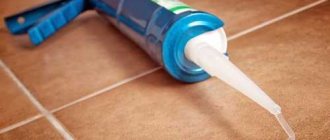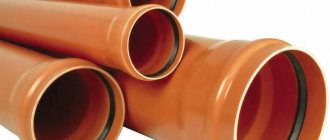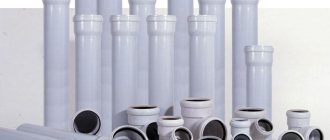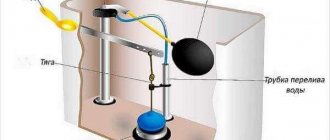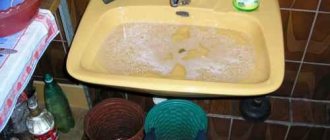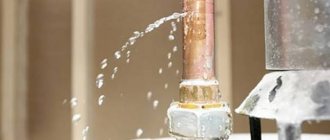Causes of accidents
In the event of an emergency, they begin repairing sewer pipes. Due to the fact that accidents are different, the approach to eliminating them will be different.
If the cause of the damage is mechanical impact, then most likely it will be necessary to carry out a major repair, that is, replace the entire pipe or its element. If the connection is simply depressurized, it will be enough to carry out minor repairs.
The causes of sewerage leaks are most often associated with the occurrence of pipe defects during their manufacture, as well as after the construction of the system - at the joints.
If a sewer pipe is leaking at the junction, you will need:
- dry the joint;
- remove accumulated dirt, cement or glue;
- close the gap between the pipes with linen winding;
- generously coat with construction sealant (more details: “How to seal a sewer pipe - a review of the advantages and disadvantages of materials and methods”);
- wait 5 hours, after which you can start using the sewer.
If it turns out that a pipe is leaking, we will consider what to cover it with, based on their specific situation. If water oozes through a cracked solution, then the cracks that appear after drying will need to be covered with silicone, epoxy or liquid rubber.
If the liquid is leaking through a crack in the pipe, then as a temporary measure, you can drive a small wooden or lead wedge into it, then wrap the damaged area with rubber or bandage and soak it with epoxy or install a clamp. A clamp would be ideal, even if it is homemade.
What to do if a plastic pipe leaks at the junction - emergency help
If you don’t know how to fix a leak in a plastic pipe or have never dealt with plumbing work, it’s better to entrust this task to specialists. Before the plumber arrives, you should turn off the water supply to avoid flooding your neighbors. It is possible to localize both a separate section and the entire system, depending on the characteristics of communications.
Clamp clamps will help you fix the accident yourself - this is the simplest and most proven way to temporarily solve the problem. To work, take a screw clamp and a small piece of plastic, clamping the place of depressurization. By the way, preliminary turning off the water for such repairs is not required, but the fastening will not last long - over time its components weaken.
Clamps for plastic pipes
Repairing cracks in sewer pipes
Due to temperature changes, small longitudinal cracks may appear on cast iron pipes.
To eliminate this problem, first of all, on the outer part of the pipe, the crack is slightly widened, dried and sealed with sealant. After this, the pipe is wrapped in a heat insulator.
There are cases when water seeps through through cracks.
In this case, eliminating the leak will be as follows:
- the cold welding method with two-component glue is suitable;
- After the glue has dried, we sand the seam, after which it can be painted over.
Sealant and epoxy glue
There can be a large number of possible circumstances for the appearance of cracks or leaks in plastic pipes. This could also be a violation of installation rules, incorrect operation, or a simple manufacturing defect. If the crack is small, you may not need to replace it, but try to seal the pipe.
The first method to carry out repair work is the use of silicone sealant. This method is suitable when the crack is not through. In most cases, this method is used when repairing sewer pipes. The flow of work will be as follows:
- The crack is cleaned and expanded if possible. This is necessary so that the sealant penetrates as deeply as possible.
- Then, you need to degrease and dry the area where the repair work is being carried out.
- After this, a layer of sealant is applied and allowed to dry.
How to repair a through hole, for example, in the same sewer pipe? In this case, it is better to use two-component epoxy glue. The work is performed in the following sequence:
- The area with the crack is cleaned, degreased and dried.
- After this, we prepare a suitable bandage. A piece of fiberglass or other dense and flexible material is best suited for this.
- The area to be repaired along the entire length of the crack is wrapped with a bandage with a reserve; in addition, the number of revolutions should be at least several.
- The last step is to apply a layer of epoxy glue.
This method is fully suitable for both sewer and water pipe repairs (for example, for a heated towel rail).
Getting rid of fistulas
Before you fix a leak in a sewer pipe, you should understand how to fix it.
You can use the first method:
- wrap the damaged area with a rubber gasket;
- tighten with a clamp.
There is an alternative method:
- if a large fistula occurs on the pipe, you will need to use a repair coupling;
- cut a piece of rubber to the size of the coupling;
- Tighten it well and the leak should stop.
It is worth noting that special plugs can be found on sale. They are installed in cleaning areas. You can additionally put a rubber gasket on the plug. The solution to sealing a cast iron sewer pipe if the leak continues may be to additionally seal the plug with silicone (pro
General recommendations on how to eliminate a leak in a polypropylene pipe
In fact, if a leak develops in a pipe, it is not always the master’s fault. Completely other factors may also play a role here:
- Incorrect temperature
when soldering polypropylene pipes. Because of this, a gap may form at the junction of the pipe and the fastening element. There is only one way to eliminate a leak in a polypropylene pipe - to replace the defective structural element with a new one.
- The nut has become loose.
If the locking nut is really just loose, then tightening it, and thereby eliminating the leakage of the tightening fitting, will not pose any problems. If the nut is defective (or the internal gasket has deteriorated), then there is a reason for more serious repairs. In such situations, some people cover up the leak with sealant. But this is only a temporary solution to eliminate leaks in a polypropylene pipe. The fitting needs to be changed, and the sooner the better.
- Poorly prepared pipe.
Polypropylene pipes with uneven cuts when installed using push-in fittings will leak in any case.
- Joints of polypropylene pipes connected with glue
, will leak if:
- the wrong type of glue was used;
- everything is fine with the adhesive, but after installing the polypropylene pipes the water was turned on too early; the glue did not have time to “grab” properly, and as a result a leak appears.
Options for repairing leaks in a polypropylene pipe can be very different, and they differ, first of all, in their quality. The most reliable way to fix a leak is to replace the damaged pipe section with a new one.
Soldering through fittings using the high-temperature mating method gives excellent results. But sometimes it is not available, and therefore in certain situations they use other methods of eliminating leaks.
So, a polypropylene pipe has burst in your house. It is quite possible to eliminate the leak on your own. This is not to say that it will be easy, but there is nothing super complicated in such a repair either. The main thing is to have the necessary tools and consumables at hand.
To eliminate leaks in polypropylene pipes using standard soldering, you will need a special soldering iron (the so-called polyfuse). But, unfortunately, it is not always at hand, or even the neighbors have it.
It is not difficult to get out of the situation in this case; there is a method of “handicraft welding”. When using this method, breaks in a polypropylene pipe are sealed using the material from which the pipe is made. What do we have to do? Apply a hot metal object (for example, a regular nail or screwdriver) to the crack. The polypropylene will begin to melt, which you need to immediately use and cover up the hole. Sometimes you don’t have to heat the nail; an ordinary lighter is enough to fix the leak.
Sometimes it is not possible to eliminate a leak in a polypropylene pipe using a soldering iron. This usually happens when a crack has formed at the junction of pipes, and getting to it with a soldering iron is problematic. In such situations, use an alternative method to fix the leak. To do this, you will need only two things: firstly, a clamp of the required size, which can be bought at any hardware store, and, secondly, a special industrial hair dryer to heat the joint. We heat until the polypropylene softens, then we put a clamp on the pipe and tighten it tightly. The leak in the polypropylene pipe has been fixed. Of course, not every person keeps an industrial hair dryer at home, but if necessary, it is easy to rent.
Read material on the topic: Wholesale sale of polypropylene pipes at competitive prices
Replacing a defective pipe
Often, due to serious damage, it is necessary to completely replace the entire pipe. To do this, you will need to stock up on tools and parts: a hacksaw for metal, flax, pipe wrenches, a sealant, a union nut and a coupling.
The sequence of work will be as follows:
- Using a metal hacksaw, the defective section of the pipe is cut out, plus 30 cm.
- We unscrew all the connections, clean the threads, and remove the cut piece of pipe.
- We make a new thread on the old pipe. To hold it, we use plumbing wrenches.
- We screw the coupling onto the pipe, after which we determine the length of the pipe to be replaced, taking into account the thread (read: “How to properly replace sewer pipes - from dismantling to installation”).
- We fix the pipe in a vice and cut off the required section.
- Using a die we cut a thread on it.
- We wrap flax around the thread and lubricate it with a sealant.
- Using a coupling, we connect the new piece of pipe to the old one.
- At the other end we join the new and old pipe with a union nut.
If emergency repair of a pipe is necessary, it can be wrapped in rubber from a bicycle inner tube and then secured with couplings.
Repair methods for cast iron pipes
When craftsmen decide how to coat a cast iron sewer pipe, they have several options to choose from:
- wind the strands;
- to settle the strands;
- use asbestos cement solution as putty.
However, before starting any work, the pipe should be cleaned to a metallic shine.
In cases where sewer pipes made of cast iron are morally and physically worn out, they are completely dismantled for replacement.
This work is carried out in several steps:
- using a grinder, cut off a section of pipe to the joint;
- the socket is freed from cement and packing residues;
- the remaining section of pipe is cut with a grinder in several places to make a stop for the lever;
- insert a crowbar into the slots and loosen the pipe along the axis;
- the last piece of pipe is removed from the socket;
- the rubber adapter coupling is mounted in the old socket;
- A new plastic sewer pipe is installed in the adapter.
Comments
April 20, 2017
Vladimir
The sewer pipe is leaking at the junction. Pass-through tee with access to the sink siphon. This is not the case when using a toilet flush barrel. The leak only occurs when the sink is used. Dismantling and remaking is a problem. I'm trying to seal the joint with sealant, but so far it hasn't worked. I dry it with a hairdryer and use different sealants. What else to do? Thank you. Sincerely, Vladimir
0 0 Reply
April 20, 2017
Mikhail (o-trubah.ru) ➜Vladimir
In such a situation, you still need to try to disassemble the connection, reassemble it and reassemble it, sealing the threads with plumbing tape. If this does not work, then you need to thoroughly dry and degrease all the parts, and therefore coat them with a sealant with good elasticity, moisture resistance and adhesion. Also, a leak in this area is possible due to the fact that water stagnates there during drainage. This problem is eliminated by cleaning the pipes mechanically or chemically.
0 0 Reply
April 25, 2017
Michael
Hello. I have a hole between the connection of a cast iron pipe and a cast iron corner under the sink in my kitchen. Is it possible to invite me for completion? Or I will have to insert a corrugated pipe deeper into the sink riser. Thereby solving the problem.
0 0 Reply
April 25, 2017
Mikhail (o-trubah.ru)
I don't think professional intervention is needed in this situation. There is no particular pressure in this area, so the option you suggested - pushing the corrugation further - is almost guaranteed to solve the problem. As an insurance policy, a potential leak can be sealed either with sealant or cold welding (after drying and degreasing, of course).
0 0 Reply


